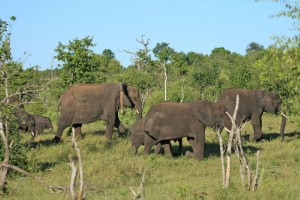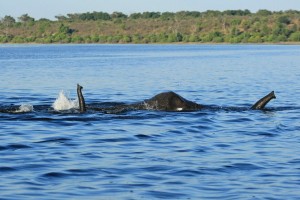Tragic News, the loss of Kachikau
It is with a heavy heart that I must write this blog and make this announcement. Recently, we discovered one of our elephant ambassadors, Kachikau, was tragically found dead. After finding her and assessing the situation and circumstances, it is believed she died from wounds, being shot, not by poachers or hunters, but simply people. Kachikau was one of three elephants that we share their stories with the San Diego Zoo’s web site campaign, Project Elephant Footprints. Out of courtesy to our kind supporters of that program, we decided it best to not announce it until they were notified first.
We want to take this opportunity to kindly Thank those donors and the San Diego Zoo for their relentless support and encouragement to our organization and projects. We sincerely appreciate all the kind words of encouragement we have been receiving from everyone at this difficult time. This tragedy only encourages our efforts, as we work together to ensure the safety and survival of elephant herds in an Africa that someday will be free of senseless losses of such magnificent animals. Thank you all, very much.
Kachikau with her calf
The following is Kachikau’s final story:
April 15, 2010
Kachikau was a large female elephant, approximately 30 years of age, and the matriarch of her family herd of 8. Her nature seemed to be one of a calm, reserved matriarch. Not once had we witnessed her show any signs of aggression or distress. She kept her calf close to her side and was an attentive mother, much to the pleasure of the young one, who seemed shy among the larger elephants.
On September 25, 2008, during the harsh dry season, Kachikau was fitted with a satellite collar. In her herd were two young calves, the first one aged about two years and the other only a few months old. The youngest looked extremely thin, and at the time our vet thought that she would not survive the remainder of the season. However, six months later, when the herd was spotted in Botswana along the Chobe River, we were relieved to learn that not only did the young calf survive, but that she belonged to Kachikau.
During the two years we followed Kachikau’s movements, she covered a 6,755-square-kilometer (2,608 square miles) area. The majority of her time was spent within the protection of the Chobe National Park, staying close to the river in the dry season but periodically crossing to feed on the grasses that occur on the floodplains. During the rains she roamed further, venturing into the forest reserves. The herd preferred the western side of the Park, which has the least amount of tourism traffic. However, when we observed her from our research vehicle, her family did not seem disturbed by our presence, sometimes walking within a few meters of us.

Kachikau with herd in Chobe
Occasionally, the herd would return to the forested area close to where we originally collared her. We believe these sporadic jaunts north were induced by the herd’s familiarity of the area and their desire for particular food sources. It was on one of these excursions that Kachikau was tragically killed.
The last time we saw Kachikau alive, she and her young calf looked healthy among several other elephant herds, forming a congregation of elephants nearly 300 strong. Only one week later, after tracking her in Chobe National Park, she crossed the river once again. We were surprised this time, only because the river was in full flood. Kachikau’s 2-year-old calf would have had to cross a 2-kilometer (1.2 miles) stretch of water with the support of the herd. Continuing on her track, Kachikau did not sway from a course that we had not observed before. To us, she had just returned to an area familiar to the herd. After 2 days, 17 kilometers (10.5 miles) from the river’s edge, Kachikau’s collar sent a GPS point from the same position. Upon discovering this, we immediately jumped in our vehicle and set out to learn why she was not moving. We were hoping that somehow the collar may have fallen off. We plotted a course on our GPS to ensure we could drive the vehicle in as close as possible to the data point. Within a few kilometers of the point, we decided there was too much surface water and had to hike the rest of the way in. Positioning ourselves to use the tracking antennae and placing the headset on, we looked up to see vultures fly from the ground into the sky. Our hearts sank, as we knew the inevitable: Kachikau was dead.
We examined the situation and all evidence as best we could. Her tusks were intact, so we believe it was not a poaching incident. We found no evidence of her herd or her young calf. We talked to the farmers that were closest to the location, and they reported that they were not having problems with elephants crop raiding, despite us noting they had no means of deterrence around their crops to stop any animals from doing so. There were no signs that Kachikau may have had any natural physical complications, either. Our initial assessment is that Kachikau had likely been shot when she crossed the river.

elephants swim the Chobe river
Unfortunately, this is not a rare occurrence. Villagers, farmers, and fisherman regularly shoot at elephants to either scare or intentionally harm them, in hopes to prevent elephants from entering fields, villages, or damaging property, such as fishing nets laid out across the river. The elephants are not necessarily actually doing the offense, but it is one method that people use to avoid potential conflict.
Kachikau’s death is tragic and sadly unnecessary. The issues surrounding the incident are extremely complex, but they threaten African elephants throughout the continent. We are currently working to address these concerns. Elephants Without Borders, with support from the San Diego Zoo, has started an ambitious new program to try to avoid these retaliatory killings and reduce human-elephant conflict. Our Elephant Conservation and Community Outreach Farming Project, the first project of its kind in southern Africa, ultimately aims at achieving a level of coexistence between elephants and people. (see: http://www.elephantswithoutborders.org/living_with_elephants.php)
Again, we sincerely appreciate all of you that have shown us your encouragement and support, but please do not let it stop here. Our new project is in its infantry stage and there is much more that we can do. If you would like to support this program, please log on to our web site at http://www.elephantswithoutborders.org/donate.php
You can read about the projects’ progress in the latest edition of “Beyond Borders: Research and Conservation with Elephants Without Borders: Progress Report, April 2010” which can be downloaded at http://www.elephantswithoutborders.org/downloads.php
Project progress will also be posted on this blog site and our Facebook page. To receive EWB periodic newsletters, you can sign up at http://elephantswithoutborders.org/phplist/?p=subscribe
Tags: africa, botswana, conservation, elephants, elephants without borders, Namibia, research, SanDiego zoo, wildlife








My God, this is so sad! My condolences to all of her surviving family, herd and people who worked with her. I pray she is in Heaven now, enjoying life she has never done before.
Hi Kelly,
I’ve been a big fan of EWB since I discovered you 2 1/2 years ago. I am sad that this happened. It should not happen to any Elephant or animal. We are the ones encroaching them in. I am wishing you all success on your new program to stop retaliatory killings and reduce human-elephant conflict.
Regards,
Ivanova